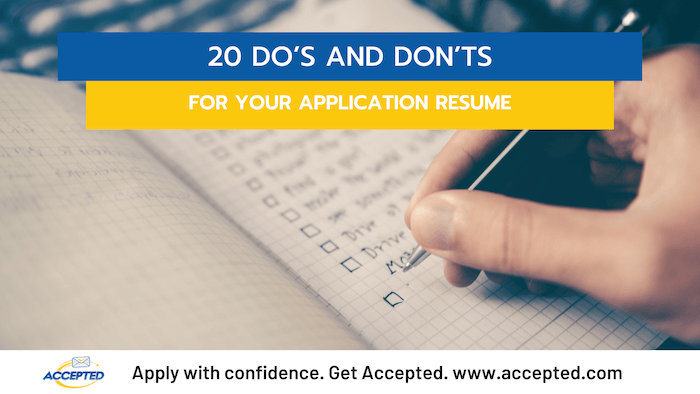Do’s and Don’ts for Your Application Resume

Your application resume is usually the first opportunity for admissions readers to get to know you and learn about your experience and skills. Because of the number of other application components they need to review, most admissions committee readers will read your resume quickly. So, not only do you have to make a great first impression – you have to do so quickly!
Fortunately, there are many ways to craft an application resume that strategically highlights your skills and makes you stand out from the crowd. The following do’s and don’ts will help you craft a dynamic resume that will allow you to sail through the admissions committee’s initial screening process and earn your outstanding qualifications the closer look they deserve.
Ten Application Resume Do’s
1. Include a Professional Profile or Qualifications section in the prime space at the top of your resume, under your name and contact information.
This will give the admissions readers a quick summary of your achievements and skills. Write this section after the rest of your resume is complete and you’ve already focused on highlighting your strongest qualifications.
2. Select resume categories based on your experience.
If you have experience in different career fields, create a separate category for each one. For example, if you worked in social services and also in marketing, your first category could be Marketing Experience, and your second category could be Social Services Experience.
Other potential categories include Publications, Patents, Presentations, Honors, Athletic Experience, Community Service, Skills, Languages, Professional Licenses, and Certifications. If you are applying to doctoral programs, you could insert a Research Experience category. Tailor your sections to your specific background.
3. Be thoughtful about the order of your resume sections.
If you have been in the workforce for more than five years, put the Experience section first. If you are a recent graduate, or if the degree you earned is more relevant to your future field of study than your experience, put the Education section first.
Positions are listed in reverse chronological order within each category, but you can order your categories so that the most relevant category is at the top. This is particularly helpful for applicants whose most recent experience is not relevant to their intended field of study. Referring back to the example in Tip #2, if you have experience in marketing and in social services and you are applying to graduate school in social work, you should make Social Services Experience your first category, even if you are working in marketing now.
4. Give the most weight to your most recent professional position, especially if it is relevant to your intended field of study.
The section of the resume for your most recent position should contain more bulleted accomplishments than your previous positions. For each position, list the accomplishments in order of decreasing relevance to the field to which you are applying. Your first bullet should capture the essential elements of your role, so that the reader can understand what you do, even if that is the only bullet they read. Remember that specific accomplishments are more impressive than descriptions of routine job duties.
5. Quantify your impact on the organizations you have worked for.
If you increased services to clients, say by how much. If you reduced expenses or increased profits, specify by what percentage. If you supervised a project, note how many people were on your team. Always ask yourself how you helped the organization, and insert numbers that demonstrate your impact. Including information on the scale and scope of your accomplishments will strengthen your resume.
6. Start each statement on your resume with an action verb.
Your bulleted statements should provide an overview of your responsibilities as well as enough detail and specifics to convey a full picture of your accomplishments. Write concise, results-focused statements using action verbs such as managed, assessed, initiated, developed, designed, instructed, streamlined, and researched.
7. Be judicious about what you leave out.
Look critically at each experience on your resume. Does including it contribute to your overall narrative? List short-term jobs or summer jobs only if they relate to your intended field of study and you do not have full-time positions that are more relevant.
For recent graduates, cocurricular (aka extracurricular) activities can demonstrate leadership, initiative, and team-building skills. Internships relevant to your field should be included; the Experience category can include both paid and unpaid work.
8. Pay as much attention to your resume’s design as you do to its content.
Use bullets or other appropriate symbols, and use a simple 10- to 11-point font for the text of the resume. Aim for one-inch margins. (If your target school provides any formatting guidelines, follow them.)
Be cautious if using a resume template. Some resume templates can limit customization, and your resume might end up not looking original.
9. Use a two-page resume, if appropriate.
Two-page resumes are fine (and in some cases, preferable) if you have been in the workforce for more than ten years or have particularly impressive work experience. Depending on your field and the degree you’re targeting, you might have a longer resume with a detailed list of publications and the like. (Once again, if your target school limits the page count of your application resume, follow its rules.) Recent graduates should usually have a one-page resume.
10. Edit, proofread, and proofread again.
Edit your resume to reduce fluff and make every word count. Set your resume aside for a few days, and then come back to it again with fresh eyes. Misspelled words and grammatical mistakes in your resume are the proverbial kiss of death for your candidacy. Once you have what you believe is the final version, show it to a mentor or friend to get a second opinion. Be sure to proofread your contact information, which includes your name, phone number, email address, city/town, and state. Most people now leave off their street address. If you include a link to your website or LinkedIn profile, be sure it is up-to-date.
Ten Application Resume Don’ts
1. Don’t make things up!
This includes inflating your accomplishments, level of responsibility, skills, or education.
2. Don’t confuse your resume with your autobiography.
The primary purpose of your resume is to focus on aspects of your experience that are relevant to your application for admission. You’ll have the rest of your application to highlight your life’s most important stories.
3. Don’t use personal pronouns (“me,” “mine,” “ours”), articles (“a” or “the”), or the word “I.”
This detracts from your resume.
4. Don’t provide personal data.
Marital status, date of birth, height/weight, and similar non-work-related information can be used to illegally discriminate against applicants, and they rarely add anything of value to your qualifications. Don’t include a photograph unless the school’s application specifically requests it.
5. Don’t repeat the same action words throughout the resume.
Rather than repeatedly using the verbs developed or led, use your thesaurus, and mix in terms such as initiated, directed, managed, delivered, and accelerated. Avoid using the phrase “responsible for.”
6. Don’t use the wrong verb tense.
Your action verbs should be in present tense for the position you currently hold (create, analyze, supervise). Use the past tense (trained, designed, chaired) for former positions.
7. Don’t leave out dates.
Even if you choose the functional resume format to minimize frequent job changes or a lack of experience, include your dates of employment somewhere on your resume (usually at the end).
8. Don’t use more detail than you need to convey your accomplishments.
Dense, paragraph-sized bullet points make for difficult reading. A good rule of thumb is to limit each bullet to one or two lines of text, with three to six accomplishments for each position. Write concisely.
9. Don’t use clichés such as dynamic and self-starting.
Let the details of your resume convince the admissions committee reader that you have these qualities without your having to state them outright.
10. Don’t overdo color or graphics on your resume.
Keep your design simple and streamlined.
Do you need help putting together a standout resume? Or do you have a professional resume and need help transforming it into one suitable to submit with your application? Schedule a free consultation and work one-on-one with an expert advisor.

By Alice Diamond, former associate dean for career and community service at Lesley University. Alice has a BA from Colgate University, an MA from Bryn Mawr College, and an MS from Cornell University. She has more than 35 years of experience in career and admissions advising for undergraduate and graduate candidates. Alice’s clients have been accepted to top programs in a wide range of fields. Want Alice to help you get accepted? Click here to get in touch!
Related Resources:
